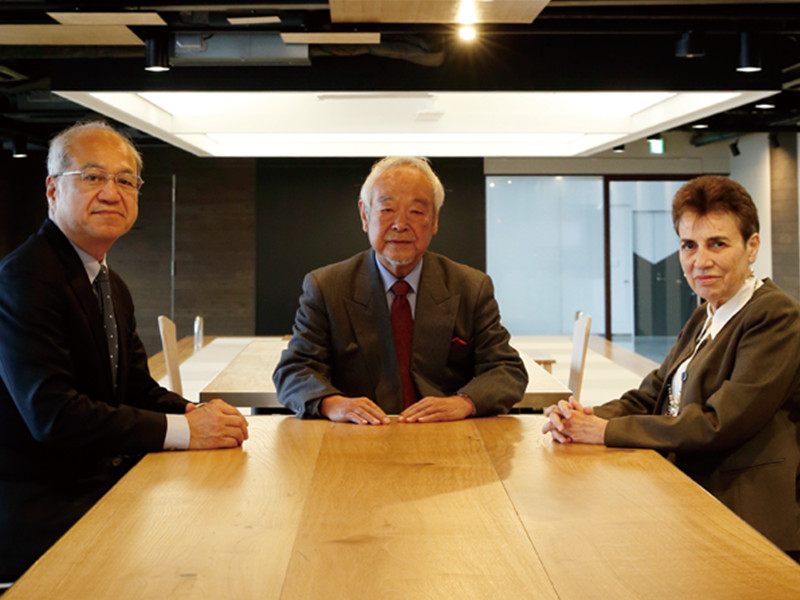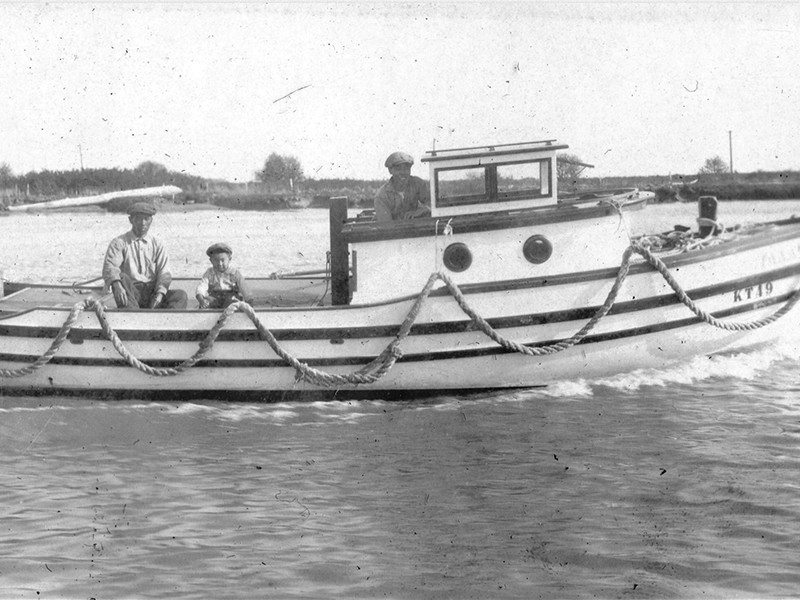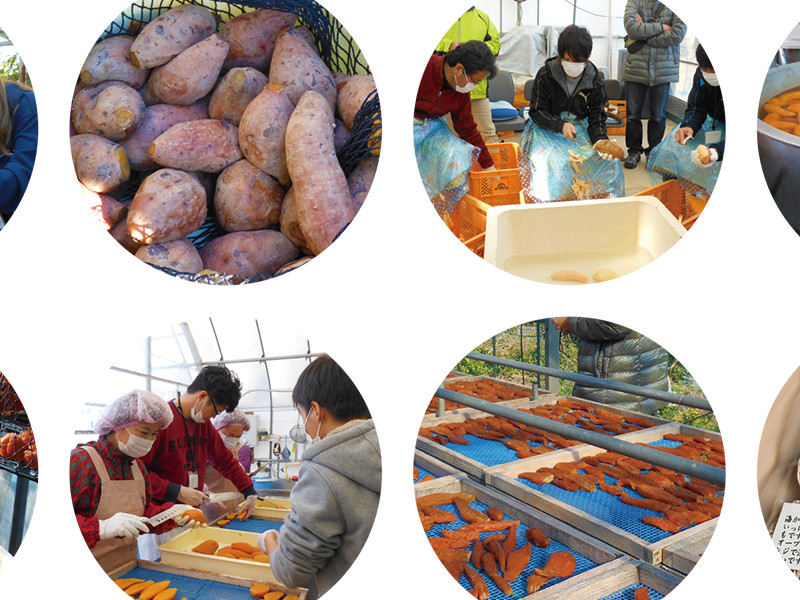SPECIAL FEATURE:Opening three-way conversation
The Past, Present,
and Future of Food
Culture Studies
Naomichi Ishige
Professor Emeritus, National Museum of Ethnology
Françoise Sabban
Professor, l'École des Hautes Études en Sciences Sociales
Toshio Asakura
Professor, College of Economics
Professor Toshio Asakura of the College of Economics is a researcher studying Korean society through food. He discussed the future of food culture studies with two famous food culture researchers—one from Japan and one from overseas—who participated in the 6th Asian Food Study Conference (AFSC) and the 2nd International Symposium by the National Museum of Ethnology and Ritsumeikan University at Ritsumeikan University's Biwako-Kusatsu campus on December 4, 2016.
Determination to research the undeveloped field of food culture by exploring food from 100 countries around the world
Asakura: Professor Ishige and Professor Sabban, please explain how you initially became involved in food culture studies.
Ishige: It was probably my marriage that made me delve into the study of food cultures. I decided to get married when I was an assistant at the Institute for Research in Humanities at Kyoto University. My salary at the time was not great and I had run up a large bar tab, so I was thinking something along the lines of, "If I get married under these circumstances, I'll look like a fool." What came to mind as a measure to pay back the bar tab was to write a book. Since majoring in cultural anthropology at university, I had conducted a lot of fieldwork in the Pacific Islands and other exotic places and had eaten a lot of rare food. I wrote about all of this in my first book, Shokuseikatsu wo Tankensuru (Exploring Food Life), in 1980.
What I realized while writing the book was that the study of food culture was really an untapped field of research. Though there were fields of research dealing with food from a scientific perspective, such as nutrition or agriculture, Japan didn't have any research exploring food cultures from the humanistic domain. I belonged to an exploration club at university, and for me, there is nothing more interesting than exploring undeveloped regions. I thus began my studies to develop a new area of study covering food cultures.
Asakura: That is really an amusing motivation for study—certainly unique to Professor Ishige, who has traveled to more than 100 countries across the globe and is known to have an "iron stomach." I have also studied Korean society from the viewpoint of cultural anthropology. The fieldwork that forms the basis of my research started with visiting a normal household in South Korea and sharing their food. While eating many different home-cooked meals, I came to realize that food is a very effective clue for learning about a country's society—and indeed its culture. And as a result of this realization, I started to conduct my studies focusing on food. What about you, Professor Sabban?
Sabban: My interest in food was cultivated by my mother. When I was young, it was not an era when there was easy access to many food ingredients—unlike today—but my mother always enthusiastically prepared delicious meals for our family. That said, I only actually started to see food as a potential subject for my studies many years later. After studying the Chinese language at the Sorbonne, I was mainly engaged in Chinese translation work. But when I joined a group to study the history of food in France and Italy in the early 1980s, food was still one of my main interests. I really started to study food history properly when I first went to China in 1983. First, to learn about Chinese cuisine, I took a six-month course on Chinese food in Taiwan. Luckily, there had been a massive political shift to democratization just before that time, and the country was starting to promote its food industry as a national policy. As part of this, I had the opportunity to translate old Chinese literature on food into modern Chinese, which I even went on to publish.
Two approaches to the study of food cultures: Fieldwork and literature reviews
Asakura: Although you are both engaged in the study of food cultures, you take completely different approaches. Please describe your own approaches to your studies.
Ishige: The foundation of all research in cultural anthropology is fieldwork. To understand food, I emphasize first putting it into my mouth and actually eating it. While conducting a survey of pasta in Italy, I ate three pasta meals a day for ten days in a row, with four kinds of pasta at each meal. At restaurants, they serve not only pasta but also a main dish and a dessert, so it was quite tough. When I returned to Japan, I was really in bad physical shape. In addition, conducting fieldwork, I really feel that food can be an important communication medium for connecting people. When I went to an unexplored region in New Guinea, I happened to become surrounded by some local people making bows and arrows. When I gave them some salt—a precious item for those people—and allowed them to lick it, they immediately withdrew their warning signals.
Asakura: I feel the same. While doing my fieldwork in Korea, I was able to earn trust by enjoying the dishes served by the families I visited for my survey work.
Sabban: I study food cultures from an historic point of view, through literature. When I studied the history of food in France and Italy, I not only translated cooking literature from Medieval French, Latin, and Italian, but also actually cooked dishes based on those recipes. In addition to the difficulties in finding the same food ingredients as those from the past, one problem I had was that even if the ingredients were indicated, the amounts were not explained. For example, if the text says, "Add a lot of cinnamon," I cannot know how much I should actually add. Overcoming these difficulties one way or another, I reproduced many recipes. Alongside my husband, who is also a food culture researcher, I perused the literature of cuisine from Renaissance and 7th century France and reproduced the recipes. I found recipes from a wide range of areas including England, Southern Italy, France, Spain, and Germany. It was interesting that while the recipes were similar, as they are all European countries, there were still delicate and subtle differences. Furthermore, as I lived in Japan for two years from 1985, I was able to improve my knowledge of the history of food in China. At that time, Japan had a better collection of Chinese literature than China itself, and I read many history books on Chinese cuisine, which allowed me to conduct a comparative study of Chinese and French food cultures.
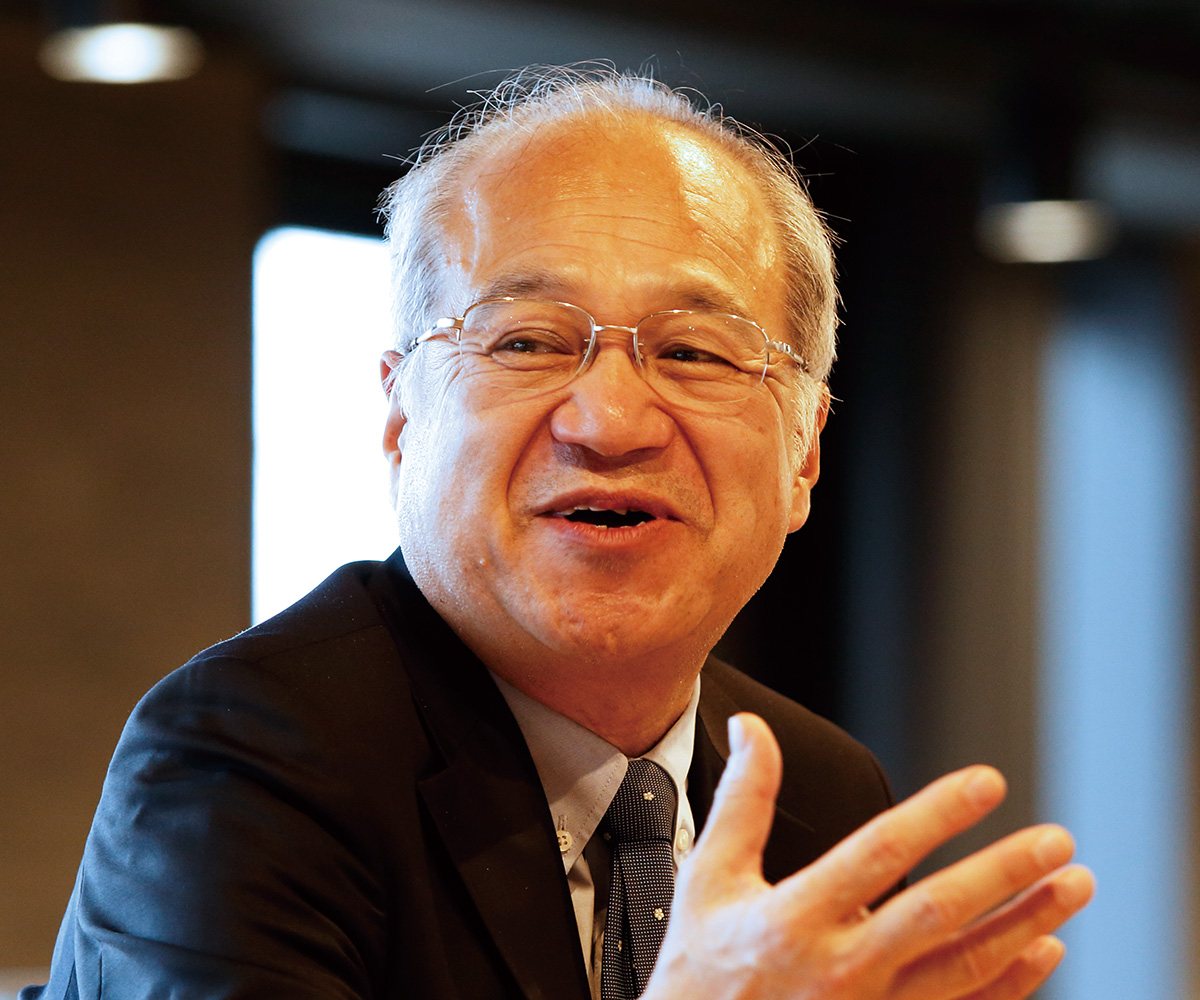
Toshio Asakura
Born in Tokyo in 1950. Graduated from the Faculty of Humanities, Musashi University. Completed doctoral program without a doctoral degree in the Graduate School of Political Science and Economics, Meiji University. Majored in social anthropology and Korean studies. After serving as Professor and Professor Emeritus of the National Museum of Ethnology, was appointed Professor of the College of Economics and Director of the International Research Center for Gastronomic Science, Ritsumeikan University, in April 2016. His books include Korean Shakai no Henbo to Ekkyo (Changes and Border-crossings of Korean Society; Rinsen Book Co.), Sekai no Shokubunka Vol. 1 Kankoku (Food Cultures of the World, Vol. 1: Korea; Rural Culture Association Japan), Nihon no Yakiniku Kankoku no Sashimi—Shokubunka ga -nize Sareru Toki (Yakiniku in Japan and Sashimi in Korea—When Food Culture is "-ized"; Rural Culture Association Japan), and many others.

Exploring the origins and differences of Asian noodles and European pasta, respectively
Asakura: You have both written many books, including some on noodles. Professor Ishige published Bunkamenruigaku Kotohajime (The Beginning of Cultural Noodlology), in 1991, while Professor Sabban's La Pasta (2012) was translated into Japanese.
Ishige: Around 1991, there were not many records comprehensively describing the history of noodles in Asia, so I decided to do it myself. I visited many countries in Central Asia to conduct a survey. While Asian noodles use flour as a raw material and there are five techniques for making them, I discovered that all originated in China. In addition, our survey revealed that Chinese noodles were introduced as far afield as the eastern coastline of the Caspian Sea, to the west of Central Asia.
Sabban: In La Pasta—Storia e cultura di un cibo universale, I summed up changes in the pasta culture developed in Europe and China, based on historic materials. Insofar as I investigated, China's influence extended to the Caspian Sea. For example, Turkey has a dish called, Manti, which was apparently introduced from China. My book also refers to cooking methods. In China, they twist and roll to make noodles, but in Italy, they roll out noodles with a mattarello, and it is never done manually. Such differences between the cooking methods of Europe and Asia are very interesting.
Asakura: Your books clearly reveal a difference in each of your approaches to studies. It is most interesting.

Naomichi Ishige
Born in Chiba in 1937. Graduated from the Faculty of Letters, Kyoto University. Doctor of Agriculture, specializing in cultural anthropology (Food culture and Comparative culture). After serving as Professor and Director of the National Museum of Ethnology, was appointed Professor Emeritus of the same museum and the Graduate University for Advanced Studies. Won the 24th Minakata Kumagusu Award. His books include Jukyokukan no Jinruigaku (Anthropology of Living Space; Kajima Institute Publishing), Shokuji no Bunmeiron (Food Civilization; Chuokoron-sha), Gyosho to Narezushi no Kenkyu—Monsoon Asia no Shokuji Bunka (Study of Fish Sauces and Fermented Sushi—Food Culture in Monsoon Asia; Iwanami Shoten), Shokutaku no Bunmeishi (History of Civilization at the Dining Table; Iwanami Gendai Bunko), Ishige Naomichi Jisen Chosakushu (Selected Works of Ishige Naomichi; twelve volumes; Domesu Publishers), and many others.
Expecting the next generation of food culture researchers to dig even deeper into food
Asakura: Professor Ishige, as a true pioneer in the study of food cultures in Japan, how do you view things?
Ishige: In the 1970s, when I started my study of food cultures, I was told, "It is embarrassing for men to discuss food," and there was even a trend that it couldn't be recognized as a genuine academic field. But over the years, interest in food has increased greatly and nowadays the number of researchers who write doctoral theses on food cultures is ever increasing. In addition, I hear that Ritsumeikan University will establish a College of Gastronomy Management. I believe this is a wonderful thing.
Asakura: The College of Gastronomy Management will be the first college in Japan where food will be totally taught and studied from an interdisciplinary viewpoint encompassing the humanities, social sciences, and natural sciences. Going forward, we aim to develop the institute into Japan's top college covering food, both in name and reality.
Finally, what is your message to the next generation of researchers who will support the study of food cultures?
Sabban: In France, quite a number of young researchers are interested in food culture. However, many of these people position food culture as a theme to be approached from the perspective of economics and other specialized fields, and I feel that the number of researchers who will actually explore food culture itself is not so great. I believe it is necessary to have an attitude of focusing on food first and deepening one's understanding of the subject by digging ever deeper.
Ishige: Food is essential for life and is something that is familiar to every living being. We tend to turn our interest to things far from us, but by maintaining the viewpoint that we ourselves and our surroundings are important subjects for research, we can discover new things.
Asakura: Thank you very much for your time today.
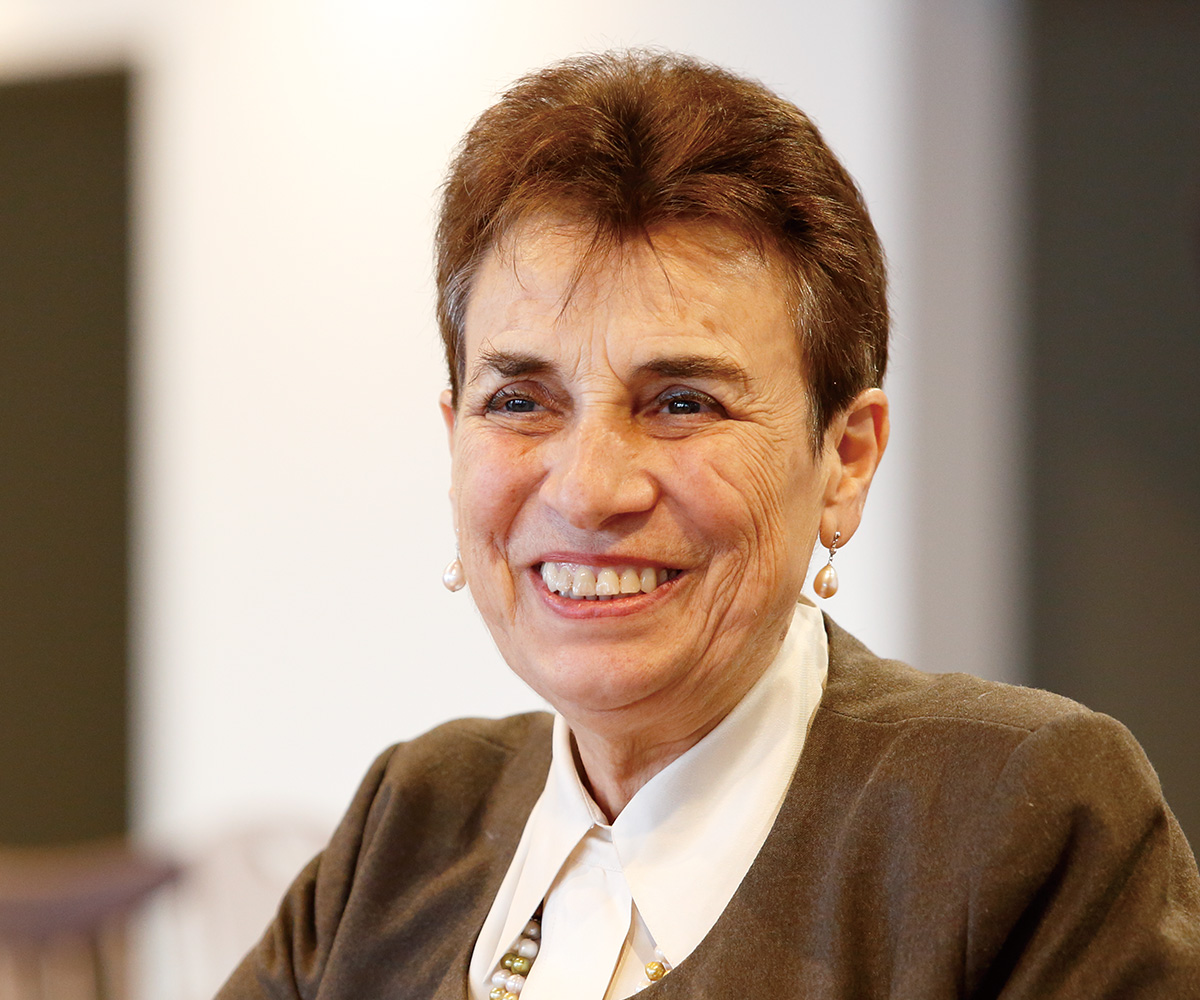
Françoise Sabban
Professor, l'École des Hautes Études en Sciences Sociales (EHESS). Director of the Maison Franco-Japonaise (2003–2008). Specializes in anthropology and the history of food in Asia and Europe, and is especially famous as a researcher of Chinese food culture. Her books include La Pasta (Hara Shobo), Un aliment sain dans un corps sain – Perspectives historiques (Presses Universitaires François Rabelais), and Les séductions du palais: Cuisiner et manger en Chine (Actes Sud Editions), among many others.

